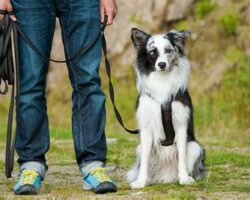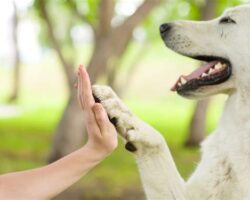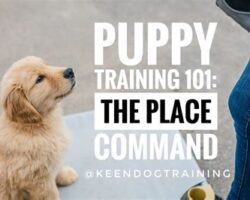Learn how to understand your puppy’s behavior, establish a training routine, choose the right method, create a designated potty area, use positive reinforcement, and deal with accidents.
Understanding your puppy’s behavior
When it comes to house training your puppy, it’s important to first understand their behavior. Puppies are just like babies, they are still learning about the world around them and are not yet able to control their bladder or bowel movements. It’s essential to be patient and understanding, as accidents are a natural part of the learning process.
During the early stages of potty training, it’s common for puppies to have accidents inside the house. This is not a sign of disobedience or lack of intelligence, but simply a result of their developing bladder control. Understanding this behavior will help you approach potty training with compassion and empathy, setting you and your puppy up for success.
By observing your puppy’s behavior and understanding their cues, you can anticipate when they need to go potty and take them to their designated potty area. This proactive approach will help reduce the number of accidents and reinforce the behavior of going potty in the right place.
Establishing a routine for training
House training a puppy can be a daunting task, but establishing a routine for training is essential for success. Consistency is key when it comes to potty training, and setting a schedule can help your new pet learn what is expected of them. Creating a routine for feeding, potty breaks, and playtime will not only make the training process easier for you, but also for your puppy.
Start by taking your puppy outside first thing in the morning, after meals, and before bedtime. This will help them learn when and where it is appropriate to relieve themselves. By sticking to a schedule, you are teaching your puppy to hold their bladder and bowels until the designated potty breaks, which is crucial for successful house training.
Additionally, incorporating regular play and exercise into your puppy’s daily routine will help burn off excess energy and reduce the likelihood of accidents. By providing mental and physical stimulation, you are also helping to establish a well-rounded and balanced routine for your pet.
Choosing the right training method
When it comes to training your puppy, it’s important to choose the right method that works best for both you and your pet. There are various training methods available, each with its own pros and cons. It’s important to do your research and understand the different techniques before deciding which one to use for your puppy.
One popular training method is the positive reinforcement technique. This involves rewarding your puppy with treats, praise, or toys when they exhibit the desired behavior. This method focuses on rewarding good behavior rather than punishing the puppy for bad behavior, which can help build a strong and positive relationship between you and your pet.
Another training method to consider is clicker training, which involves using a small device that makes a clicking sound to signal to your puppy that they have performed the correct behavior. This method can be effective in teaching your puppy new commands and tricks, and it allows for clear communication between you and your pet.
Creating a designated potty area
Creating a designated potty area
House training a new puppy can be a challenging task, but with the right approach and a designated potty area, it can be much easier. Creating a designated potty area in your home is essential for effectively teaching your puppy where it is appropriate to go to the bathroom.
When selecting a designated potty area, it’s important to choose a spot that is easily accessible to your puppy and away from high-traffic areas of the home. Establishing a routine for training is also crucial, as it will help your puppy learn when and where to go to the bathroom. Consistency is key in this process, so be sure to always take your puppy to the designated potty area at the same times each day.
Using positive reinforcement techniques can also be very effective. When your puppy successfully goes to the bathroom in the designated area, be sure to use positive reinforcement such as treats or praise to reward them for their good behavior. This will help them understand that going in the designated potty area is the desired behavior.
Consistency is key in training
Consistency is a crucial factor when it comes to training your new puppy. It’s important to establish a routine and stick to it in order to effectively teach your pet the proper behaviors. Whether it’s potty training, crate training, or basic obedience, maintaining a consistent schedule will help your puppy learn and adapt more quickly.
Consistency also applies to the rules and expectations you set for your puppy. If you allow your pet to jump on the couch one day and then scold them for it the next, they will become confused and hesitant. By consistently enforcing the same rules and boundaries, you can avoid confusion and help your puppy understand what is expected of them.
Additionally, consistency in your own behavior and reactions is crucial. Your puppy looks to you for guidance and reassurance, so it’s important to respond to their actions in a consistent manner. This will help build trust and a better understanding between you and your pet.
Positive reinforcement techniques for success
Positive reinforcement techniques for success
When it comes to house training puppies, using positive reinforcement techniques can be incredibly effective in teaching your new pet where to go potty. Instead of punishing your puppy for accidents, focus on praising and rewarding them for good behavior. This can help create a positive association with potty training and make the process more enjoyable for both you and your furry friend.
One of the most important aspects of positive reinforcement is timing. Make sure to give your puppy immediate praise or a treat as soon as they eliminate in the designated potty area. This will help them understand that their action is what earned the reward. Consistency is key, so be sure to provide positive reinforcement every time your puppy goes potty in the right spot.
In addition to treats and praise, consider using verbal cues to help your puppy understand where they are supposed to go potty. For example, saying go potty as your puppy is eliminating can help them associate that phrase with the action. Over time, they will learn to go potty on command, making the training process even more efficient.
Dealing with accidents and setbacks
House training a new puppy can be a challenging task, and it’s important to be prepared for accidents and setbacks along the way. Accidents are a natural part of the learning process, especially for young puppies who are still getting the hang of controlling their bladder and bowels. It’s crucial to approach these accidents with patience and understanding, as getting frustrated or angry will only hinder your progress.
One of the best ways to handle accidents is to clean up thoroughly and promptly. Use a pet-specific cleaner to remove any traces of the accident scent, as this will help prevent your puppy from being drawn back to the same spot. It’s also important to refrain from punishing your puppy for accidents, as this can create anxiety and fear around potty training.
Setbacks are also common during the house training process. Your puppy may have a few good days and then suddenly start having accidents again. This can be frustrating, but it’s important to stay consistent with your training and continue to provide positive reinforcement for good behavior. Keep in mind that setbacks are normal and don’t indicate a failure on your part – they’re simply a part of the learning curve for your new pet.
Frequently Asked Questions
When should I start potty training my new puppy?
It is best to start potty training your puppy as soon as you bring them home, typically around 8-12 weeks of age.
What are some essential tips for potty training a puppy?
Some essential tips for potty training a puppy include establishing a routine, using positive reinforcement, supervising your puppy, and being patient and consistent.
Should I use puppy pads for potty training?
Puppy pads can be useful for potty training, especially if you live in an apartment or have limited outdoor space. However, it is important to eventually transition your puppy to outside potty training.
How long does it take to potty train a puppy?
The time it takes to potty train a puppy can vary, but with consistent training and positive reinforcement, most puppies can be fully potty trained within 4-6 months.
What should I do if my puppy has an accident inside the house?
If your puppy has an accident inside the house, it is important to clean the area thoroughly to remove any scent markers. Avoid scolding or punishing your puppy, as this can lead to fear and anxiety around potty training.
What are signs that my puppy needs to go potty?
Some signs that your puppy needs to go potty include sniffing the ground, circling, whining, or suddenly stopping play. It is important to pay attention to your puppy’s behavior and take them outside frequently, especially after eating, drinking, or waking up from a nap.
What if my puppy is having difficulty with potty training?
If your puppy is having difficulty with potty training, it may be helpful to consult a professional dog trainer or behaviorist for personalized guidance. It is also important to rule out any medical issues that could be impacting your puppy’s potty training progress.





